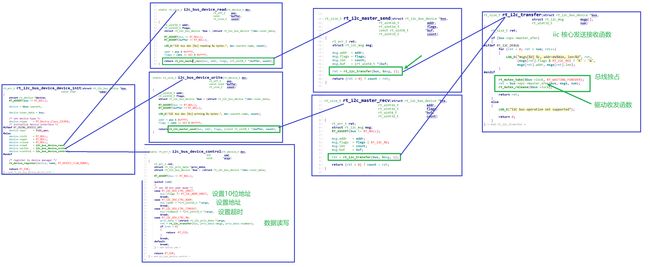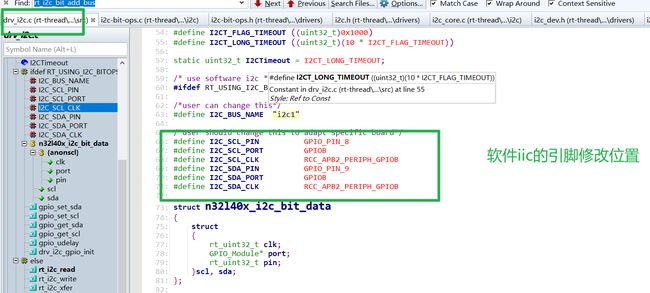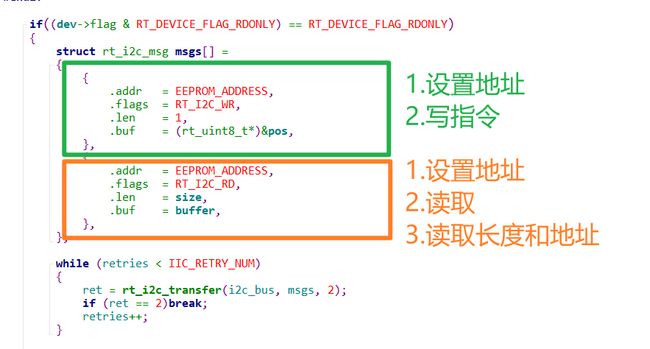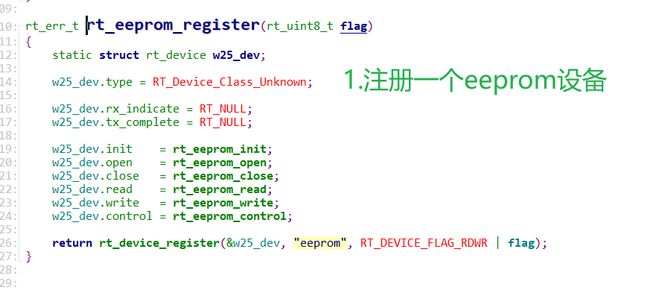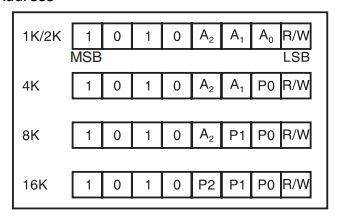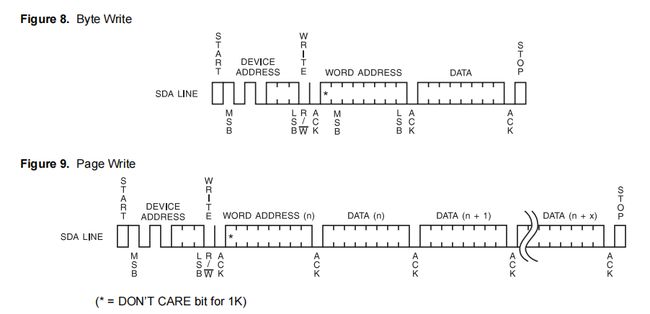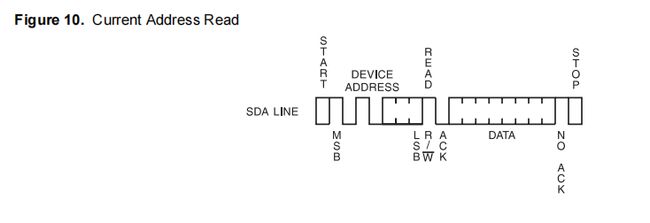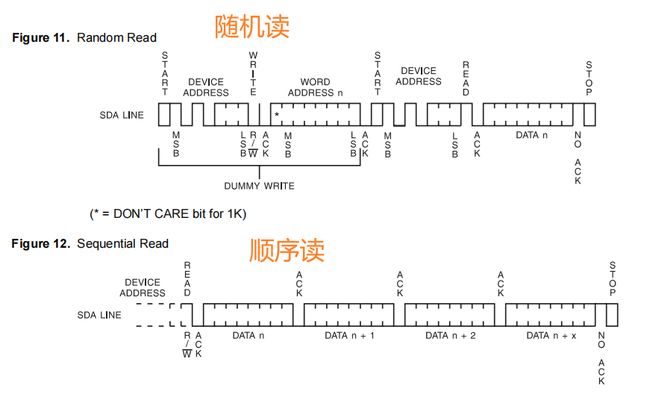【RTT驱动框架分析04】-I2C驱动框架分析
IIC
RT-Thread IIC 应用编程
2.驱动分析
IIC总线设备继承自io设备驱动框架,RTT对IIC就只有2层的封装
IIC设备总线,在RTT内部有软件IIC和硬件IIC
设备驱动注册
rt_err_t rt_i2c_bus_device_register(struct rt_i2c_bus_device *bus,
const char *bus_name)
iic bus 抽象模型
struct rt_i2c_bus_device
{
struct rt_device parent;//继承自设备驱动
const struct rt_i2c_bus_device_ops *ops;//iic bus 操作结构体
rt_uint16_t flags;
rt_uint16_t addr;
struct rt_mutex lock;//bus 涉及iic设备独占的问题
rt_uint32_t timeout;
rt_uint32_t retries;
void *priv;
};
iic bus 操作函数集
下边基于N32L40x 的iic驱动{软件和硬件方式}实现都仅仅实现了master_xfer 驱动函数,slave_xfer和i2c_bus_control均没有实现
struct rt_i2c_bus_device_ops
{
rt_size_t (*master_xfer)(struct rt_i2c_bus_device *bus,
struct rt_i2c_msg msgs[],
rt_uint32_t num);
rt_size_t (*slave_xfer)(struct rt_i2c_bus_device *bus,
struct rt_i2c_msg msgs[],
rt_uint32_t num);
rt_err_t (*i2c_bus_control)(struct rt_i2c_bus_device *bus,
rt_uint32_t,
rt_uint32_t);
};
接收函数
RTT 基于N32的硬件IIC实现的
static int rt_i2c_read(rt_uint32_t i2c_periph, rt_uint16_t slave_address, rt_uint8_t* p_buffer, rt_uint16_t data_byte)
{
I2CTimeout = I2CT_LONG_TIMEOUT;
/* wait until I2C bus is idle 等待总线空闲*/
while(I2C_GetFlag((I2C_Module*)i2c_periph, I2C_FLAG_BUSY))
{
if ((I2CTimeout--) == 0)
return 9;
};
//使能自动ack
I2C_ConfigAck((I2C_Module*)i2c_periph, ENABLE);
/** Send START condition 发送开始信号*/
I2C_GenerateStart((I2C_Module*)i2c_periph, ENABLE);
I2CTimeout = I2CT_LONG_TIMEOUT;
/* wait until SBSEND bit is set 等待开始信号发送完成*/
while (!I2C_CheckEvent((I2C_Module*)i2c_periph, I2C_EVT_MASTER_MODE_FLAG)) // EV5
{
if ((I2CTimeout--) == 0)
return 10;
};
/* send slave address to I2C bus 发送地址和操作类型*/
I2C_SendAddr7bit((I2C_Module*)i2c_periph, slave_address, I2C_DIRECTION_RECV);
I2CTimeout = I2CT_LONG_TIMEOUT;
//等待地址和操作类型发送完成
while (!I2C_CheckEvent((I2C_Module*)i2c_periph, I2C_EVT_MASTER_RXMODE_FLAG)) // EV6
{
if ((I2CTimeout--) == 0)
return 6;
};
/* while there is data to be read 持续读取多个数据*/
while(data_byte)
{
/* wait until the RBNE bit is set and clear it等待接收缓冲准备就绪或非空 */
if(I2C_GetFlag((I2C_Module*)i2c_periph, I2C_FLAG_RXDATNE))
{
/* read a byte 读取一个数据*/
*p_buffer = I2C_RecvData((I2C_Module*)i2c_periph);
/* point to the next location where the byte read will be saved */
p_buffer++;
/* decrement the read bytes counter */
data_byte--;
if(1 == data_byte)
{
/* disable acknowledge 最后一个数据不在自动产生ack*/
I2C_ConfigAck((I2C_Module*)i2c_periph, DISABLE);
/* send a stop condition to I2C bus 最后一个数据接收后自动产生停止信号*/
I2C_GenerateStop((I2C_Module*)i2c_periph, ENABLE);
}
}
}
/* wait until the stop condition is finished等待停止信号发送完成 */
while(I2C_GetFlag((I2C_Module*)i2c_periph, I2C_FLAG_STOPF))
{
if ((I2CTimeout--) == 0)
return 7;
};
/* enable acknowledge 使能自动ack*/
I2C_ConfigAck((I2C_Module*)i2c_periph, ENABLE);
I2C_ConfigNackLocation((I2C_Module*)i2c_periph,I2C_NACK_POS_CURRENT);
return 0;
}
发送函数
static int rt_i2c_write(rt_uint32_t i2c_periph, uint16_t slave_address, uint8_t* p_buffer, uint16_t data_byte)
{
uint8_t* sendBufferPtr = p_buffer;
I2CTimeout = I2CT_LONG_TIMEOUT;
//等待iic设备空闲
while (I2C_GetFlag((I2C_Module*)i2c_periph, I2C_FLAG_BUSY))
{
if ((I2CTimeout--) == 0)
return 4;
};
//自动ack
I2C_ConfigAck((I2C_Module*)i2c_periph, ENABLE);
//发送开始信号
I2C_GenerateStart((I2C_Module*)i2c_periph, ENABLE);
//等待开始信号发送完成
I2CTimeout = I2CT_LONG_TIMEOUT;
while (!I2C_CheckEvent((I2C_Module*)i2c_periph, I2C_EVT_MASTER_MODE_FLAG)) // EV5
{
if ((I2CTimeout--) == 0)
return 5;
};
//发送地址和发送指令
I2C_SendAddr7bit((I2C_Module*)i2c_periph, slave_address, I2C_DIRECTION_SEND);
I2CTimeout = I2CT_LONG_TIMEOUT;
//等待指令和地址发送完成
while (!I2C_CheckEvent((I2C_Module*)i2c_periph, I2C_EVT_MASTER_TXMODE_FLAG)) // EV6
{
if ((I2CTimeout--) == 0)
return 6;
};
// send data持续发送多个数据
while (data_byte-- > 0)
{
//发送一个数据
I2C_SendData((I2C_Module*)i2c_periph, *sendBufferPtr++);
I2CTimeout = I2CT_LONG_TIMEOUT;
//等待数据发送完成
while (!I2C_CheckEvent((I2C_Module*)i2c_periph, I2C_EVT_MASTER_DATA_SENDING)) // EV8
{
if ((I2CTimeout--) == 0)
return 7;
};
};
//等待数据发送完成
I2CTimeout = I2CT_LONG_TIMEOUT;
while (!I2C_CheckEvent((I2C_Module*)i2c_periph, I2C_EVT_MASTER_DATA_SENDED)) // EV8-2
{
if ((I2CTimeout--) == 0)
return 8;
};
//产生一个停止信号
I2C_GenerateStop((I2C_Module*)i2c_periph, ENABLE);
return 0;
}
iic总线设备驱动分析
软件IIC驱动实现与注册
硬件IIC驱动实现与注册
RTT封装的IIC驱动框架调用流程
软件模式iic设备总线引脚更改
在drv_ic.c文件中更改
软件iic注册
硬件iic总线设备引脚修改
iic总线的使用
- 定义eeprom读函数-驱动内部会每个数据包会重新 发起开始和停止信号
/* SPI Dev device interface, compatible with RT-Thread 0.3.x/1.0.x */
static rt_size_t rt_eeprom_read(rt_device_t dev,
rt_off_t pos,
void *buffer,
rt_size_t size)
{
static struct rt_i2c_bus_device *i2c_bus;
int ret = 0;
int retries = 0;
#if defined(RT_USING_I2C1)
i2c_bus = rt_i2c_bus_device_find("i2c1");
#endif
#if defined(RT_USING_I2C2)
i2c_bus = rt_i2c_bus_device_find("i2c2");
#endif
if((dev->flag & RT_DEVICE_FLAG_RDONLY) == RT_DEVICE_FLAG_RDONLY)
{
struct rt_i2c_msg msgs[] =
{
{
.addr = EEPROM_ADDRESS,
.flags = RT_I2C_WR,
.len = 1,
.buf = (rt_uint8_t*)&pos,
},
{
.addr = EEPROM_ADDRESS,
.flags = RT_I2C_RD,
.len = size,
.buf = buffer,
},
};
while (retries < IIC_RETRY_NUM)
{
ret = rt_i2c_transfer(i2c_bus, msgs, 2);
if (ret == 2)break;
retries++;
}
if (retries >= IIC_RETRY_NUM)
{
rt_kprintf("%s i2c read error: %d", __func__, ret);
return 0;
}
return ret;
}
else
{
return 0;
}
}
-
定义eeprom写函数
static rt_size_t rt_eeprom_write(rt_device_t dev, rt_off_t pos, const void *buffer, rt_size_t size) { static struct rt_i2c_bus_device *i2c_bus; #if defined(RT_USING_I2C1) i2c_bus = rt_i2c_bus_device_find("i2c1"); #endif #if defined(RT_USING_I2C2) i2c_bus = rt_i2c_bus_device_find("i2c2"); #endif if((dev->flag & RT_DEVICE_FLAG_RDONLY) == RT_DEVICE_FLAG_RDONLY) { I2C_EE_WriteBuffer(i2c_bus, (uint8_t*)buffer, pos, size); return size; } else { return 0; } } -
注册一个eeprom
eeprom 使用IIC示例
AT24C02
-
8个字节每页,累计32个页
-
通讯频率MAX = 400K
-
AT24C02大小 2K
- 芯片地址
eeprom_at24c02.h
/*****************************************************************************
* Copyright (c) 2022, Nations Technologies Inc.
*
* All rights reserved.
* ****************************************************************************
*
* Redistribution and use in source and binary forms, with or without
* modification, are permitted provided that the following conditions are met:
*
* - Redistributions of source code must retain the above copyright notice,
* this list of conditions and the disclaimer below.
*
* Nations' name may not be used to endorse or promote products derived from
* this software without specific prior written permission.
*
* DISCLAIMER: THIS SOFTWARE IS PROVIDED BY NATIONS "AS IS" AND ANY EXPRESS OR
* IMPLIED WARRANTIES, INCLUDING, BUT NOT LIMITED TO, THE IMPLIED WARRANTIES OF
* MERCHANTABILITY, FITNESS FOR A PARTICULAR PURPOSE AND NON-INFRINGEMENT ARE
* DISCLAIMED. IN NO EVENT SHALL NATIONS BE LIABLE FOR ANY DIRECT, INDIRECT,
* INCIDENTAL, SPECIAL, EXEMPLARY, OR CONSEQUENTIAL DAMAGES (INCLUDING, BUT NOT
* LIMITED TO, PROCUREMENT OF SUBSTITUTE GOODS OR SERVICES; LOSS OF USE, DATA,
* OR PROFITS; OR BUSINESS INTERRUPTION) HOWEVER CAUSED AND ON ANY THEORY OF
* LIABILITY, WHETHER IN CONTRACT, STRICT LIABILITY, OR TORT (INCLUDING
* NEGLIGENCE OR OTHERWISE) ARISING IN ANY WAY OUT OF THE USE OF THIS SOFTWARE,
* EVEN IF ADVISED OF THE POSSIBILITY OF SUCH DAMAGE.
* ****************************************************************************/
/**
* @file i2c_eeprom.h
* @author Nations
* @version V1.2.1
*
* @copyright Copyright (c) 2022, Nations Technologies Inc. All rights reserved.
*/
#ifndef __I2C_EEPROM_H__
#define __I2C_EEPROM_H__
#include eeprom_at24c02 .c
/*****************************************************************************
* Copyright (c) 2022, Nations Technologies Inc.
*
* All rights reserved.
* ****************************************************************************
*
* Redistribution and use in source and binary forms, with or without
* modification, are permitted provided that the following conditions are met:
*
* - Redistributions of source code must retain the above copyright notice,
* this list of conditions and the disclaimer below.
*
* Nations' name may not be used to endorse or promote products derived from
* this software without specific prior written permission.
*
* DISCLAIMER: THIS SOFTWARE IS PROVIDED BY NATIONS "AS IS" AND ANY EXPRESS OR
* IMPLIED WARRANTIES, INCLUDING, BUT NOT LIMITED TO, THE IMPLIED WARRANTIES OF
* MERCHANTABILITY, FITNESS FOR A PARTICULAR PURPOSE AND NON-INFRINGEMENT ARE
* DISCLAIMED. IN NO EVENT SHALL NATIONS BE LIABLE FOR ANY DIRECT, INDIRECT,
* INCIDENTAL, SPECIAL, EXEMPLARY, OR CONSEQUENTIAL DAMAGES (INCLUDING, BUT NOT
* LIMITED TO, PROCUREMENT OF SUBSTITUTE GOODS OR SERVICES; LOSS OF USE, DATA,
* OR PROFITS; OR BUSINESS INTERRUPTION) HOWEVER CAUSED AND ON ANY THEORY OF
* LIABILITY, WHETHER IN CONTRACT, STRICT LIABILITY, OR TORT (INCLUDING
* NEGLIGENCE OR OTHERWISE) ARISING IN ANY WAY OUT OF THE USE OF THIS SOFTWARE,
* EVEN IF ADVISED OF THE POSSIBILITY OF SUCH DAMAGE.
* ****************************************************************************/
/**
* @file i2c_eeprom.c
* @author Nations
* @version V1.2.1
*
* @copyright Copyright (c) 2022, Nations Technologies Inc. All rights reserved.
*/
/**
* @file i2c_eeprom.c
* @author Nations
* @version V1.2.1
*
* @copyright Copyright (c) 2022, Nations Technologies Inc. All rights reserved.
*/
#include 

